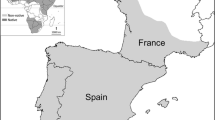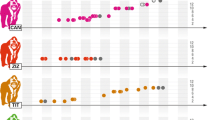Abstract
Based on cross-sectional and longitudinal data collected in 1967–1988 by various observers, male reproductive success was studied in the Hanuman langurs of Jodhpur, India. The harem-structured social organization ensures a high degree of paternity certainty. Births occur throughout the year, with significant peaks and minima in March and November, respectively (n =398).The interbirth interval averages 16.7 months (n = 114).The duration of harem residencies varies between 3 days and ≥ 74.0 months, with a mean of 26.5 (n = 64). Harem holder replacements occur during all months of the year. No male achieves residency in more than one troop, suggesting that residency is associated with a distinct peak in the resource holding potential of a given male. Reproductive success among males varies considerably. Male mortality is high due to migration and intrasexual competition, leading to an adult sex ratio of 1:4.9. It is estimated that one-quarter of all adult males will never gain harem residency. Conceptions achieved outside harem residencies are so rare (4.7%) that a viable low-risk strategy, opting for longevity instead of harem residency, is unlikely. Tenure length has a stronger influence on male reproductive success than harem size because interbirth intervals are significantly shorter in small harems than in larger ones. It is assumed that females in one-male breeding structures compete for sperm and that such competition is more intense in larger harems.
Similar content being viewed by others
References
Agoraraoorthy, G. (1987).Reproductive Behaviour in Hanuman Langurs, Presbytis entellus; Ph.D. thesis, University of Jodhpur, Jodhpur.
Agoramoorthy, G., and Mohnot, S. M. (1988). Infanticide and juvenilicide in Hanuman langurs (Presbytis entellus) around Jodhpur, India.Hum. Evol. 3: 279–296.
Altmann, J., Hausfater, G., and Altmann, S. (1988). Determinants of reproductive success in savannah baboons,Papio cynocephalus. In Clutton-Brock, T. H. (ed.),Reproductive Success: Studies of Individual Variation in Contrasting Breeding Systems, University of Chicago Press, Chicago and London, pp. 403–418.
Bhargava, S. K., Sinha, R., and Dixit, V. P. (1984). Long-term metabolic effect of clofibrate (atromid-s) on the testicular function of normolipaemic langurs (Presbytis entellus entellus): A histologial and biochemical study. In Roonwal, M. L., Mohnot, S. M., and Rathore, N. S. (ed.),Current Primate Researches, University of Jodphur Press, Jodhpur, pp. 83–91.
Borries, C. (1988). Patterns of grandmaternal behaviour in free-ranging Hanuman langurs (Presbytis entellus).Hum. Evol. 3: 239–260.
Cheney, D. L., Seyfarth, R. M., Andelman, S. J., and Lee, P. C. (1988). Reproductive success in vervet monkeys. In Clutton-Brock, T. H. (ed.),Reproductive Success: Studies of Individual Variation in Contrasting Breeding Systems, University of Chicago Press, Chicago and London, pp. 384–402.
Chism, J. M., and Rowell, T. E. (1986). Mating and residence patterns of male patas monkeys.Ethology 72: 31–39.
Clutton-Brock, T. H. (1988).Reproductive Success: Studies of Individual Variation in Contrasting Breeding Systems, University of Chicago Press, Chicago and London.
Clutton-Brock, T. H. (1989). Female transfer and inbreeding avoidance in social mammals.Nature (Lond.J 337: 70–71.
Cords, M. (1984). Mating patterns and social structure in redtailed monkeys (Cercopithecus Ascanius).Z. Tierpsychol. 64: 313–329.
David, G. F. X., and Ramaswami, L. S. (1971). Reproductive systems of the North Indian langur (Presbytis entellus entellus Dufresne).J. Morphol. 135: 99–130.
Dunbar, R. I. M. (1984).Reproductive Decisions: An Economic Analysis of Gelada Baboon Social Strategies, Princeton University Press, Princeton, N.J.
Dunbar, R. I. M. (1988).Primate Social Systems, Croom Helm, London and Sydney.
Emlen, S., and Oring, L. (1977). Ecology, sexual selection and the evolution of mating systems.Science 197: 215–225.
Harcourt, A. H., and Stewart, K. J. (1981). Gorilla relationships: can differences during immaturity lead to contrasting reproductive tactics in adulthood?Anim. Behav. 29: 206–210.
Harcourt, A. H., Harvey, P. H., Larson, S. G., and Short, R. V. (1981). Testis weight, body weight and breeding system in primates.Nature (Lond.) 293: 55–57.
Harley, D. (1985). Birth spacing in langur monkeys (Presbytis entellus).Int. J. Primatol. 6: 227–242.
Hausfater, G., Aref, S., and Cairns, S. J. (1982). Infanticide as an alternative male reproductive strategy in langurs: A mathematical model.J. Theor. Biol. 94: 391–412.
Kummer, H. (1984).Social Organization of Hamadryas Baboons, Karger, Basel.
Lohiya, N. K., Sharma, O. P., and Sharma, R. C. (1986). Testis function and sexual potential in langur monkey treated with a combination steroidal contraceptive formulation.Contraception 34: 417–433.
Makwana, S. C. (1979). Infanticide and social change in two groups of the Hanuman langer.Presbytis entellus, at Jodhpur. Primates 20: 293–300.
Makwana, S. C., and Advani, R. (1981). Social changes in Hanuman langur, Presbytis entellus, around Jodhpur.J. Bombay Nat. Hist. Soc. 78: 152–154.
Mathur, R., and Lobo, A. (1986). Ecology and behaviour ofPresbytis entellus with special reference to adult male takeovers and infanticide.National Symposium on Conservation and Use of Primates in Biomedical Research, 19–20 December, 1986, Jaipur, p. 18 (abstr.).
Maynard Smith, J., and Price, G. R. (1973). The logic of animal conflict.Nature (Lond.J 246: 15–18.
Mohnot, S. M. (1971a). Ecology and behaviour of the Hanuman langur.Presbytis entellus (Primates: Cercopithecidae) invading fields, gardens and orchards around Jodhpur, western India.Trop. Ecol. 12: 237–349.
Mohnot, S. M. (1971b). Some aspects of social changes and infant-killing in the Hanuman langur,Presbytis entellus entellus (Primates: Cercopithecidae) in western India.Mammalia 35: 175–198.
Mohnot, S. M. (1974).Ecology and Behaviour of the Common Indian Langur, Presbytis entellus, Ph.D. thesis, University of Jodhpur, Jodhpur.
Mohnot, S. M., Gadgil, M., and Makwana, S. C. (1981). The dynamics of the Hanuman langur population of Jodhpur, Rajasthan, India.Primates 22: 182–191.
Moore, J. (1985).Demography and Sociality in Primates, Ph.D. thesis, Harvard University, Cambridge, Mass.
Newton, P. N. (1987). The social organization of forest Hanuman langurs (Presbytis entellus).Int. J. Primatol. 8: 199–232.
Newton, P. N. (1988). The variable social organization of Hanuman langurs (Presbytis entellus), infanticide, and the monopolization of females.Int. J. Primatol. 9: 59–77.
Oppenheimer, J. R. (1977).Presbytis entellus, the Hanuman langur. In H. S. H. Rainier, and Bourne, G. H. (ed.),Primate Conservation, Academic Press, New York, pp. 469–512.
Parker, G. A. (1974). Assessment strategy and the evolution of animal conflicts.J. Theoret. Biol. 47: 223–43.
Pramanik, S. K., and Hariharan, P. S. (1952). The climate of Rajasthan.Bull. Natl. Inst. Sci. India 1 (Proc. Symp. Rajputana Des): 167–178.
Rajpurohit, L. S. (1987).Male Social Organisation in Hanuman Langur, Presbytis entellus, Ph.D. thesis, University of Jodhpur, Jodhpur.
Rajpurohit, L. S., and Mohnot, S. M. (1988). Fate of ousted male residents of one-male bisexual troops of Hanuman langurs (Presbytis entellus) at Jodhpur, Rajasthan (India).Hum. Evol. 3: 309–318.
Rajpurohit, L. S., and Sommer, V. (1990). Differential mortality by sex in the langurs (Presbytis entellus) of Jodhpur/Rajasthan.Folia primatol. (in press).
Roonwald, M. L., and Mohnot, S. M. (1977).Primates of South Asia: Ecology, Sociobiology and Behavior, Harvard University Press, Cambridge, Mass.
Sachs, L. (1972).Statistische Auswertungsmethoden, Springer, Berlin.
Short, R. V. (1981). Sexual selection in man and the great apes. In Graham, C. E. (ed.),Reproductive Biology of the Great Apes. Academic Press, New York, pp. 319–341.
Small, M. F. (1988). Female primate sexual behavior and conception: Are there really sperm to spare?Curr. Anthropol. 29: 81–100.
Sommer, V. (1985).Weibliche und mÄnnliche Reproduktionsstrategien der Hanuman-Languren (Presbytis entellus) von Jodhpur, Rajasthan/India, Ph.D., dissertation, Georg-August-UniversitÄt, Göttingen.
Sommer, V. (1987). Infanticide among free-ranging langurs (Presbytis entellus) at Jodhpur (Rajasthan/India): Recent observations and a reconsideration of hypotheses.Primates 28: 163–197.
Sommer, V. (1988).Male competition and coalitions in langurs (Presbytis entellus) at Jodhpur, Rajasthan, India.Hum. Evol. 3: 261–278.
Sommer, V. (1989). Sexual harassment in langur monkeys (Presbytis entellus): Competition for ova, sperm, and nurture?Ethology 80: 205–217.
Srivastava, A. (1989).Feeding Ecology and Behaviour of Hanuman Langur, Presbytis entellus, Ph.D. thesis, University of Jodhpur, Jodhpur.
Srivastava, A., Mohnot, S. M., and Rajpurohit, L. S. (1986). Bisexual troops of Hanuman langur (Presbytis entellus) in a predominantly one-male troop habitat.Abstracts, International Symposium on Primates —The New Revolution, New Delhi, India, 26–31 December 1986, pp. 41–42.
Strum, S. C., and Western, J. D. (1982). Variation in fecundity with age and environment in olive baboons (Papio anubis).Am. J. Primatol. 3: 61–76.
Sugiyama, Y. (1965). On the social change of Hanuman langurs (Presbytis entellus) in their natural conditions.Primates 6: 381–417.
Trivers, R. L. (1972). Parental investment and sexual selection. In Campbell, B. (ed.),Sexual Selection and the Descent of Man. Chicago University Press, Chicago, pp. 136–179.
Tsingalia, H. M., and Rowell, T. E. (1984). The behaviour of adult male blue monkeys.Z. Tierpsychol. 64: 253–268.
Vogel, C. (1977). Ecology and sociology ofPresbytis entellus. In Prasad, M. R. N., and Anand Kumar, T. C. (ed.),Use of Non-human Primates in Biomedical Research, Indian Nat. Sci. Acad., New Delhi, pp. 24–45.
Vogel, C. (1979). Der Hanuman Langur (Presbytis entellus), ein Parade-Exempel für die theoretischen Konzepte der Soziobiologie?Verhandl. Dtsch. Zool. Ges. 72: 73–89.
Vogel, C., and Loch, H. (1984). Reproductive parameters, adult-male replacements, and infanticide among free-ranging langurs (Presbytis entellus) at Jodhpur (Rajasthan), India. In Hausfater, G., and Hrdy, S. B. (ed.),Infanticide: Comparative and Evolutionary Perspectives, Aldine, New York, pp. 237–255.
Winkler, P. (1981).Zur öko-Ethologie freilebender Hanuman-Languren (Presbytis entellus Dufresne, 1797) in Jodhpur (Rajasthan), Indien, Ph.D. dissertation, Georg-August-Universitat, Gottingen.
Winkler, P. (1988a). Feeding behavior of a food-enhanced troop of Hanuman langurs (Presbytis entellus) in Jodhpur, India. In Fa, J. E., and Southwick, C. H. (ed.),The Ecology and Behavior of Food-Enhanced Primate Groups, Alan R. Liss, New York, pp. 3–24.
Winkler, P. (1988b). Troop history, female reproductive strategies and timing of male change in Hanuman langurs.Presbytis entellus. Hum. Evol. 3: 227–237.
Winkler, P., Loch, H., and Vogel, C. (1984). Life history of Hanuman langurs (Presbytis entellus): Reproductive parameters, infant mortality, and troop development.Folia Primatol. 43: 1–23.
Author information
Authors and Affiliations
Rights and permissions
About this article
Cite this article
Sommer, V., Rajpurohit, L.S. Male reproductive success in harem troops of hanuman langurs (Presbytis entellus). Int J Primatol 10, 293–317 (1989). https://doi.org/10.1007/BF02737419
Received:
Revised:
Issue Date:
DOI: https://doi.org/10.1007/BF02737419




